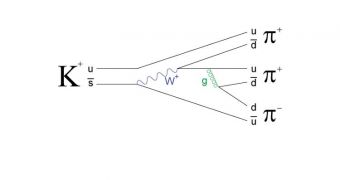The decay process of a subatomic particle called a kaon was the focus of a new research effort, conducted by an international team of physicists. Their work revealed in exquisite detail how the particle decays, a finding that may help us explain how matter appeared in the Universe.
At this point, though the Big Bang model is widely accepted in the cosmological community, the theory still does not answer a series of very important questions, such as why is there matter in the Universe, when equal amounts of matter and antimatter were produced from the get-go?
The new analysis of kaon decay can also reveal why we – and everything else in the Cosmos – are not made up of antimatter, rather than normal, baryonic matter. This investigation was made possible through the use of IBM supercomputers, Daily Galaxy reports.
According to study coauthor Taku Izubuchi, there are only two possible explanation for why baryonic matter exists – either more of it formed during the Big Bang (which is unlikely), or some other mechanism created an imbalance between normal matter and antimatter, favoring the former.
The expert is based at both the RIKEN-BNL Research Center and the US Department of Energy's (DOE) Brookhaven National Laboratory (BNL), in Long Island, New York.
“This calculation brings us closer to answering fundamental questions about how matter formed in the early Universe and why we, and everything else we observe today, are made of matter and not anti-matter,” University of Connecticut associate physics professor and study coauthor, Thomas Blum, says.
The BNL is the site where first kaon decay measurements were conducted. The researchers who led those investigations got the 1964 Nobel Prize in Physics for their work. That study represented the first time that the asymmetry between particles and their anti-particle was reported experimentally.
Izubuchi says that the new research was able to determine that the kaon decay process spans more than 18 orders of magnitude, before the subatomic particles splits into two pions. This range has been compared to that between the sizes of a single bacterium and that of the solar system.
In order to conduct this study, experts used 54 million processor hours on the IBM BlueGene/P supercomputer, located at the DOE Argonne National Laboratory, near Chicago, Technology Review reports.

 14 DAY TRIAL //
14 DAY TRIAL //